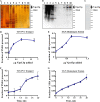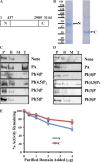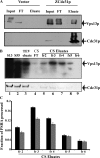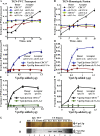The Vps13p-Cdc31p complex is directly required for TGN late endosome transport and TGN homotypic fusion
- PMID: 28122955
- PMCID: PMC5294781
- DOI: 10.1083/jcb.201606078
The Vps13p-Cdc31p complex is directly required for TGN late endosome transport and TGN homotypic fusion
Abstract
Yeast VPS13 is the founding member of a eukaryotic gene family of growing interest in cell biology and medicine. Mutations in three of four human VPS13 genes cause autosomal recessive neurodegenerative or neurodevelopmental disease, making yeast Vps13p an important structural and functional model. Using cell-free reconstitution with purified Vps13p, we show that Vps13p is directly required both for transport from the trans-Golgi network (TGN) to the late endosome/prevacuolar compartment (PVC) and for TGN homotypic fusion. Vps13p must be in complex with the small calcium-binding protein Cdc31p to be active. Single-particle electron microscopic analysis of negatively stained Vps13p indicates that this 358-kD protein is folded into a compact rod-shaped density (20 × 4 nm) with a loop structure at one end with a circular opening ∼6 nm in diameter. Vps13p exhibits ATP-stimulated binding to yeast membranes and specific interactions with phosphatidic acid and phosphorylated forms of phosphatidyl inositol at least in part through the binding affinities of conserved N- and C-terminal domains.
© 2017 De et al.
Figures








Comment in
-
Vps13 and Cdc31/centrin: Puzzling partners in membrane traffic.J Cell Biol. 2017 Feb;216(2):299-301. doi: 10.1083/jcb.201612026. Epub 2017 Jan 25. J Cell Biol. 2017. PMID: 28122956 Free PMC article.
Similar articles
-
The synaptojanin-like protein Inp53/Sjl3 functions with clathrin in a yeast TGN-to-endosome pathway distinct from the GGA protein-dependent pathway.Mol Biol Cell. 2003 Apr;14(4):1319-33. doi: 10.1091/mbc.e02-10-0686. Mol Biol Cell. 2003. PMID: 12686590 Free PMC article.
-
Golgi-to-late endosome trafficking of the yeast pheromone processing enzyme Ste13p is regulated by a phosphorylation site in its cytosolic domain.Mol Biol Cell. 2005 Mar;16(3):1456-68. doi: 10.1091/mbc.e04-07-0642. Epub 2005 Jan 12. Mol Biol Cell. 2005. PMID: 15647379 Free PMC article.
-
Cell-free reconstitution of transport from the trans-golgi network to the late endosome/prevacuolar compartment.J Biol Chem. 2004 Nov 19;279(47):48767-73. doi: 10.1074/jbc.M406368200. Epub 2004 Sep 13. J Biol Chem. 2004. PMID: 15364946
-
Protein transport from the late Golgi to the vacuole in the yeast Saccharomyces cerevisiae.Biochim Biophys Acta. 2005 Jul 10;1744(3):438-54. doi: 10.1016/j.bbamcr.2005.04.004. Biochim Biophys Acta. 2005. PMID: 15913810 Review.
-
Yeast vacuole fusion: a model system for eukaryotic endomembrane dynamics.Autophagy. 2008 Jan;4(1):5-19. doi: 10.4161/auto.5054. Epub 2007 Sep 12. Autophagy. 2008. PMID: 17932463 Review.
Cited by
-
Vacuolar Protein-Sorting Receptor MoVps13 Regulates Conidiation and Pathogenicity in Rice Blast Fungus Magnaporthe oryzae.J Fungi (Basel). 2021 Dec 17;7(12):1084. doi: 10.3390/jof7121084. J Fungi (Basel). 2021. PMID: 34947066 Free PMC article.
-
Role of the endolysosomal system in Parkinson's disease.J Neurochem. 2019 Sep;150(5):487-506. doi: 10.1111/jnc.14820. Epub 2019 Jul 31. J Neurochem. 2019. PMID: 31287913 Free PMC article. Review.
-
Cryo-EM reconstruction of a VPS13 fragment reveals a long groove to channel lipids between membranes.J Cell Biol. 2020 May 4;219(5):e202001161. doi: 10.1083/jcb.202001161. J Cell Biol. 2020. PMID: 32182622 Free PMC article.
-
Identification of two compound heterozygous VPS13A large deletions in chorea-acanthocytosis only by protein and quantitative DNA analysis.Mol Genet Genomic Med. 2020 Sep;8(9):e1179. doi: 10.1002/mgg3.1179. Epub 2020 Feb 14. Mol Genet Genomic Med. 2020. PMID: 32056394 Free PMC article.
-
Vps13 and Cdc31/centrin: Puzzling partners in membrane traffic.J Cell Biol. 2017 Feb;216(2):299-301. doi: 10.1083/jcb.201612026. Epub 2017 Jan 25. J Cell Biol. 2017. PMID: 28122956 Free PMC article.
References
-
- Abazeed M.E., and Fuller R.S.. 2008. Yeast Golgi-localized, gamma-Ear-containing, ADP-ribosylation factor-binding proteins are but adaptor protein-1 is not required for cell-free transport of membrane proteins from the trans-Golgi network to the prevacuolar compartment. Mol. Biol. Cell. 19:4826–4836. 10.1091/mbc.E07-05-0442 - DOI - PMC - PubMed
MeSH terms
Substances
Grants and funding
LinkOut - more resources
Full Text Sources
Other Literature Sources
Molecular Biology Databases
Miscellaneous

